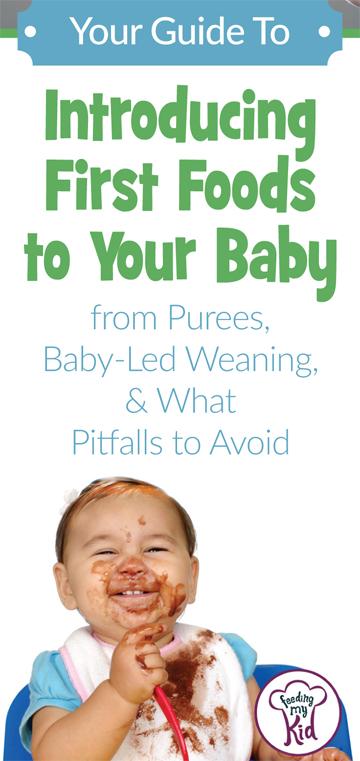 Welcome to the wonderful world of introducing first foods to your baby! Food introduction is a fun milestone for you and your baby.
Welcome to the wonderful world of introducing first foods to your baby! Food introduction is a fun milestone for you and your baby.
This ultimate guide is long, so bookmark it if you can’t finish it all at once.
Here is everything I wish someone would’ve told me when I started solids.
When to Start Solids?
A child should only be given breast milk or formula until four to six months of age. A number of studies show that you should wait until your baby is six months olds before introducing solid foods. The main reason for waiting is that: “babies have to develop the proper gut bacteria that allow them to process solid food safely, potentially leading to gastroenteritis and diarrhea”, Dr. T J Gold, a pediatrician with Tribeca Pediatrics in Brooklyn, said. “The early introduction of solid foods has also been linked to increased risk of obesity, diabetes, eczema and celiac disease.” (1)
Subscribe to our Youtube Channel for our video series about how to best feed your baby, toddler, and school-aged child.
Preemies
For preemies, use the adjusted age. If the baby was born two months early, then introduce foods at eight months and not six months.
How Do You Know When Your Baby Is Ready?
Some babies are born early and others late; some fly through their developmental milestones, while others are go at their own pace. Starting to introduce solids is just another milestone that you should tie to your own child’s development. Some studies show benefits to starting to wean at four months, while others say the process shouldn’t start before six months. It’s best to work with your pediatrician to see what she recommend for your child.
No study supports the theory that if you add rice cereal to a bottle at night, your baby will sleep longer. Please be cautious when considering this option for your baby, as your baby’s digestive system might not be mature enough for rice cereal, especially before six months of age (1).
Please check with your pediatrician before introducing solids.
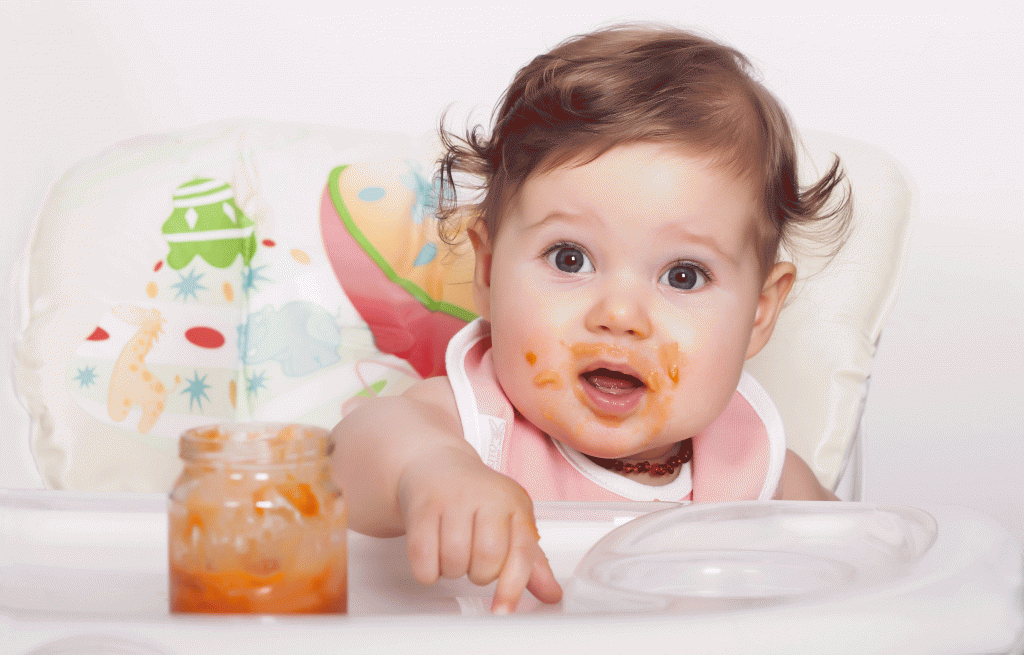
Signs Your Child is Ready:
- Does your child hold his head up well?
- Can your child sit up on her own or with some support?
- Is your child starting to chew on toys or his hands?
- Is your child putting things in her mouth?
- Is your child showing interest in food?
If you see these signs, your child is probably ready to start solid foods (2). Congratulations!
Do you plan on making your own baby foods or buying the pre-made baby foods from supermarkets?
Will you start with purees, baby-led weaning, or a mixture of both?
Check out our top picks for bibs, spoons, highchairs, and plates/ trays.
Introducing Solids Video Series:
Part 1: Introducing Solids What I Wish Someone Told Me
Part 2: Understanding Food Allergies
Pre-Made Baby Food vs Store Bought Baby Food
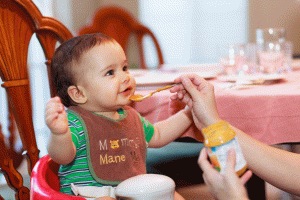 Will you make your own baby food or buy pre-made baby food? Find out the pros and cons of each choice. This is something I really wish I had understood when I was introducing solids to my own twins.
Will you make your own baby food or buy pre-made baby food? Find out the pros and cons of each choice. This is something I really wish I had understood when I was introducing solids to my own twins.
Find out why it’s important to add texture to your baby food as early as seven months! It is essential that you add texture to your baby food or move up stages quickly if you are using pre-made baby food.
We recommend you move up to Stage 3 baby food as early as 7-8 months versus the 9 months it says on the jar. Pre-made baby food is much smoother in consistency, so moving up to stage 3 food early on will help introduce your child to texture.
Keep in mind, if your baby is not tolerating textures well, pull back and always go at your baby’s pace! Each child is different and some babies struggle with texture. However, if you wait too long to introduce textures to your child, she can be very resistant because she has become accustomed to overly pureed food.
How Do You Know When Your Baby Is Full?
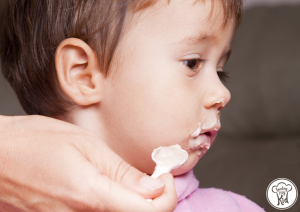 Check out this article to find out how to read your baby’s signals to tell you he is full.
Check out this article to find out how to read your baby’s signals to tell you he is full.
The one essential step is to make sure you remain 100% neutral to your child’s eating. Do not show her that you are stressed out about her lack of eating. Try not to show your excitement that she ate a new food. Be neutral. This tip is hard to follow, but you don’t want your baby to eat to make you happy, which can turn into overeating.
You want your baby to learn to listen to his own body cues for hunger and fullness and not to overeat because he thinks it will make you happy. Babies need very little food at each sitting and they are the absolute best at deciding how much to eat.
If you feel he didn’t eat enough food, unless you’re seriously worried about his nutrient intake, find peace with it, because your baby is the best at knowing when to stop.
Related Reading:
-
-
- Six Feeding Tips For Parents with Infants Turning Six Months
- Introducing First Foods to Your Baby: What I wish someone told me [Part 1]
- Introducing First Foods to Your Baby: What I wish someone told me [Part 2]
- Baby 4 – 7 Months: Find Out How to Shape Your Baby’s Taste Buds For a Lifetime
- Is My Child’s Eating Normal at 9-12 Months of Age? Find Out What’s Normal.
- Childhood BMI Can Predict Obesity Starting at Early as 6 Months
-
Foods to Avoid
 A common misconception is that children should avoid eggs and yogurt as they begin eating solids. Actually, those foods are encouraged as long as there is no family history of allergies to them. Make sure the eggs are fully cooked before offering them to your baby. Check out the list of the
A common misconception is that children should avoid eggs and yogurt as they begin eating solids. Actually, those foods are encouraged as long as there is no family history of allergies to them. Make sure the eggs are fully cooked before offering them to your baby. Check out the list of the
Check out the list of the top 8 food allergies. The article also covers
The article also covers what allergic reactions looks like in babies and what to do.
Avoid salt and honey before the age of one. A baby’s kidneys struggle to process salt and honey is dangerous for babies because of infant botulism.
High-sugar foods such as cookies and candy should be avoided along with offering any type of juice. Find out why you shouldn’t offer juice at this age. The occasional prune or pear juice is ok to help with constipation. Check with your doctor for her recommendations before introducing any foods to your baby.
Understanding Your Baby’s Taste Buds
Babies and toddlers naturally prefer sweeter foods. Nonetheless, you can absolutely help your child get used to and accept the flavor of savory vegetables.
A baby’s sense of taste is generally much stronger than an adult’s. The great news is that as with anything else with your baby, you are teaching taste. By consistently exposing your child to savory vegetables, your child can grow to appreciate and love savory flavors.
Research shows it can take as much as 20+ exposures of a food for a baby and toddler to develop a taste for it. Don’t give up!
Change up the preparation or flavor of the foods. We all have foods we like and do not like. Your baby will eventually prefer some foods over others and that is ok. You can still continue to present the foods you would like your child to eat and she can decide to eat the food or not.
Relieving Your Anxiety
It is completely NORMAL for babies to make a funny face when you are introducing a new food. This face is NOT telling you he doesn’t like avocado 😉
 The face is telling you that solid foods are different and unexpected to your baby.
The face is telling you that solid foods are different and unexpected to your baby.
Until you start feeding her solids, your baby’s diet has been 100% liquid. Everything is new and different. Put yourself in your baby’s shoes; what if someone was putting a spoon full of mush in your mouth in the dark, and you had no idea what it would taste like or feel like in your mouth? You would be a little shocked too.
How Babies and Children Learn to Eat
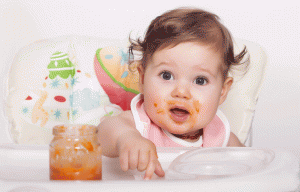 Babies learn to eat through looking, touching, tasting, wearing and spitting out food. Yes, even wearing it!
Babies learn to eat through looking, touching, tasting, wearing and spitting out food. Yes, even wearing it!
“Your child will warm up slowly to unfamiliar foods and may have to be presented with a food 15 or 20 or dozens of times – in as many meals – before he learns to eat it,” according to Ellyn Satter, Registered Dietitian Nutritionist and Family Therapist.
Let your baby wear his food. Do not clean up your baby up until after the meal. Babies need to “experience” their food.
Your Choice Of a High Chair is Important
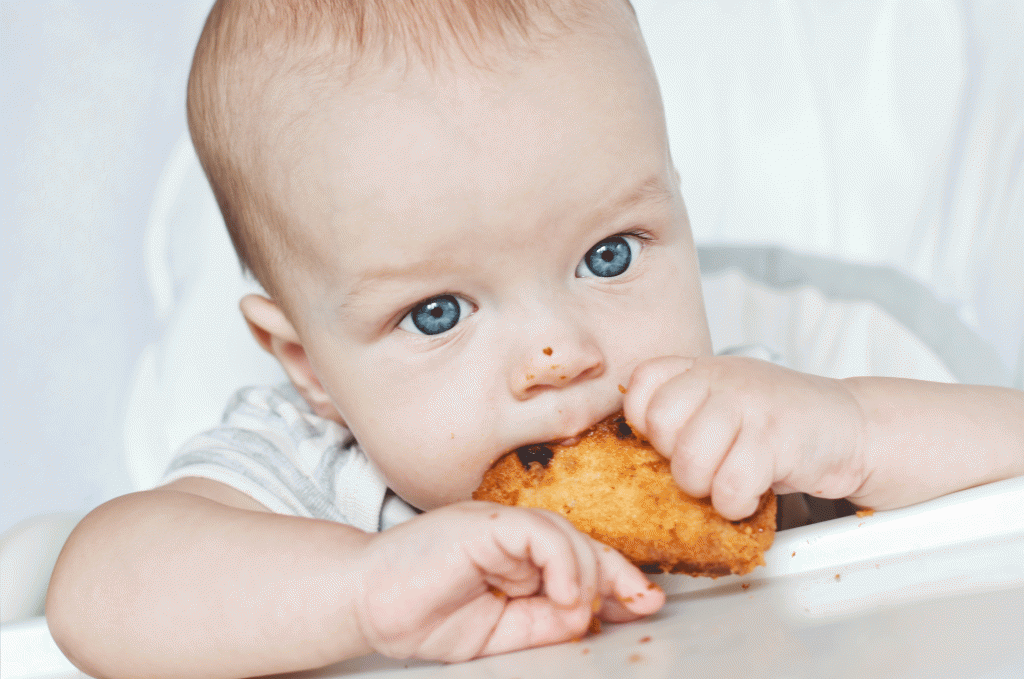 Do your best to eat your meal at the same time your baby eats. Babies learn by imitating, so it’s important for your baby to see you eating.
Do your best to eat your meal at the same time your baby eats. Babies learn by imitating, so it’s important for your baby to see you eating.
We recommended high chairs that allow you to push the chair up to your table so your baby is a part of every mealtime as young as six months.
Your child’s posture is very important. Make sure your child is sitting up at a 90-degree angle, and never feed your baby in a reclined position, in which food is more likely to fall to the back of the child’s throat and become a choking risk. Check out the article about our high chair recommendations and why.
Find Out Why Posture is so Incredibly Important When Finding a High Chair
Why You Should Eat With Your Baby
Mealtimes are meant to be social. “Babies can begin to learn about how different foods are eaten, how to share, how to wait their turn, and how to make conversation. Sharing mealtimes has a positive impact on family relationships, social skills, language development, and healthy eating,” according to the authors of the book, Baby-Led Weaning, Gill Rapley and Tracey Murkette.
Start enjoying family meals together.
Is My Baby Choking or Gagging?
Does it look like your baby is gagging or about to throw up? Then your baby is probably gagging, not choking.
Choking is a serious situation when the airway is partially or completely blocked. The child will likely change color quickly to a grey/blue. If this occurs, start the baby Heimlich right away to remove the obstruction.
 Gagging is when our baby is learning how to maneuver food in his or her mouth and sometimes makes mistakes. To learn more about gagging and choking check out this accompanying article, which has some important info about what what to do if your baby is gagging too much.
Gagging is when our baby is learning how to maneuver food in his or her mouth and sometimes makes mistakes. To learn more about gagging and choking check out this accompanying article, which has some important info about what what to do if your baby is gagging too much.
Tongue thurst is when some babies seem to push all the food out of their mouth. Again, this is normal. This is called a tongue thrust. Most babies outgrow this by six months, but some take a little longer. If this continues to happen, try taking a break from offering solids for a few weeks and then re-offer the food again. The tongue thrust reflex should be gone between 7-8 months old; if it continues, speak with your pediatrician about getting an evaluation with an occupational therapist or other feeding specialist.
Making My Own Baby Food
- What to Know Before Making My Own Baby Food
- Making Your Own Baby Food: Cooking Techniques
- Differences in Baby Food Stages and Puree Texture
Our Favorite Puree Recipes:
Our Top Picks for Introducing Solids
- Best High Chair & Booster Seat Recommendations
- Plates, Mats and Feeding Trays
- Plates, Placemats and Feeding Trays
- Small Baby Bowls
- Sippy Cups with Straw
- What Supplies Do I Need To Introduce Solid Foods?
How Much Should My Child Be Eating?
During the first year of life, on average, babies grow 10 inches (25 centimeters) in length and their body weight increases by 300%. This is one of the reasons babies need to eat so often at this phase. It’s hard work growing 300% in a single year.
Generally, a baby will eat about 1-2 tablespoons of food to start with, which won’t seem like a lot. Eventually, by about 8-9 months, she will move up to about 4-8 tablespoons of food per day. Each child is different.
Some will eat more and some will eat less depending on factors like how much breastmilk and/or formula they’re consuming and how much they’re growing. Speak with your doctor if you are concerned that your baby is not eating enough or does not take pleasure in eating.
Feeding Schedule:
Each baby wakes and eats differently. Follow your baby’s cues for a schedule that works for your family. At this stage, breast milk or formula is your child’s primary source of nutrition and fluids. You should always nurse or bottle-feed your baby first and a few hours later offer your baby a solid food.
When your child is about six months old, experts recommend offering her a new food in the morning so you can monitor her for any possible allergic reactions. In the coming weeks, you can introduce a second feeding at lunch or dinner.
If your baby is too hungry, generally the solid feeding will not go well. Likewise, if your baby is too full from nursing or formula, your baby will probably be uninterested in eating the solid food you are offering.
You may not want to start out offering solids multiple times a day. Most parents start off at around 8-9 months by offering solids once a day and work their way up to three times a day. This is an example schedule:
6 am: Nurse or bottle-feed
8 am: Breakfast
10 am: Nurse or bottle-feed
12 pm: Lunch
2 pm: Nurse or bottle-feed
4-5 pm Dinner
6 pm: Nurse or bottle-feed
It is completely normal for a baby to eat 1 tablespoon or even 2 tablespoons of one food group and not eat anything else. Studies show that in general your child’s nutrient intake will even out throughout the week, so this is completely normal and healthy. As the parent, just keep offering your child healthy food options with each meal.
Generally, babies that feed in the middle of the night will eat less during the day.
There are no studies supporting the theory that if you add rice cereal to a bottle at night that your baby will sleep longer. Read the article to find out if it’s a good or bad idea.
My Child Doesn’t Have Enough Teeth To Chew Food
It’s ok if your child has no teeth at this point! Children don’t need teeth as long as the food you provide them is cut up small and cooked so it is very soft. A child’s gums are strong enough to grind food. Check out all the ways to prepare food for your baby.
When Can I Introduce Spices To My Child?
Some pediatricians will say to wait until about eight months of age, but that is not necessarily for allergy reasons. This advice is mostly given to make sure a child’s stomach is strong enough to handle a possible upset from the spice or herb.
Find out how to add spices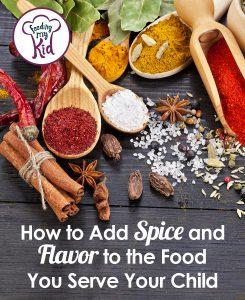 to your baby’s food.
to your baby’s food.
Around seven months, you can start introducing spices like cinnamon. Clean your child’s face after eating cinnamon; although completely normal, it can irritate the skin if left on it for too long.
The more foods and flavors a child is introduced to and gets used to eating, the less likely the child is to turn away from eating the food later on (4).
Think about kids from other countries. Many don’t have processed baby foods like we do in the US, so international families will often introduce whatever the family is eating.
This can include curry, chili’s, cilantro and turmeric. Check out the complementary article, Baby-Led Weaning.
If At First You Don’t Succeed, Try and Try Again
Babies, toddlers, and preschoolers are cautious about trying new foods. Keep offering these foods over and over again. Even if you’ve offered green beans 5 to 10 times, don’t think your child just doesn’t like green beans. Keep changing up the preparation, adding different spices and herbs and mixing them with different ingredients.
There are many studies that show a child’s preferences are still changing, so help them learn to love their veggies. It can take 20+ exposures! My son has been exposed to eggs a million different ways and he still won’t eat them, but I won’t give up.
I do not pressure him to eat the eggs. It’s important to remain neutral. I don’t even encourage him to take a bite. Often, any form of pressure will backfire, so be completely neutral at all times regarding food (3).
I make eggs a few times a week and I put a small amount on my son’s tray. He can decide to eat the eggs or not. My daughter loves eggs. He may never like eggs and that is ok!
Model The Behavior You Want Your Kids To Do
If you want your kids to eat their veggies, make sure you are eating them too (4). Learn more about this in the article: If you don’t like your brussels sprouts, chances are your kids won’t either.
Why Babies Don’t Always Eat
Babies do not eat for so many reasons. Your baby might be teething, constipated, getting sick or just too tired. It happens! If you are at all concerned, please call your doctor.
If your baby is too hungry, generally the solid feeding will not go well. If your baby is too full from nursing or formula, your baby will probably be uninterested in eating the solid food you are offering.
What Foods Should I Introduce By Age?
While introducing solid foods to your child, continue breastfeeding or formula feeding. Do not transition your child to cow’s milk or another milk until after 12 months or until your doctor recommends it. Always check with your pediatrician before making any changes to your baby’s diet.
Around 6 months: The amount of breastmilk or formula should remain the same. You can start introducing fruits, vegetables, rice cereals, dairy (yogurt, cottage cheese, cheese, etc), eggs, meat, fish and beans.
That seems like a lot of variety…because it is! The only thing you should avoid is honey and salt. Also, make sure your cheeses are pasteurized. Don’t offer your child raw cheese.
Our Favorite Puree Recipes:
Here is our guide to everything you need to know about making your own baby food, including:
- Cooking baby food
- Storing, freezing and thawing baby food
- Which to do? Making my own baby food versus store-bought baby food?
Baby Food Consistency
No matter if you make your own baby food or buy store-bought baby food, you should start by thinning out whatever baby food you offer your baby with breastmilk or formula. Over the course of the next few weeks, start to thin out the puree less and less until you have a thicker consistency. Go at your baby’s pace. It is important to go from runny purees to thicker purees to mashed food with a lot of texture. See the differences here.
What if my child’s tongue pushes all the food out, gags or throws up?
My kid makes a funny face; does he hate what I’m serving?
7 months old: You can start introducing a sippy cup filled with breast milk and/or formula. You can also add a little water into the sippy cup so your child can start getting used to a sippy cup during mealtimes. It’s important you understand how texture works for your baby. If you give your baby a peach (not pureed), it has two very different textures- the inside of the peach and its fuzzy skin.
Some children have a harder time with mixed textures. Other children, mine included, have a hard time with the sliminess of most fruits and vegetables. I ended up having to introduce dehydrated fruits and veggies until my twins overcame their texture aversions.
I also noticed that, if I gave my kids half of a banana they eagerly ate it, but when I sliced up the banana they would never touch it. It was the same for strawberries. Play with different textures and change up the preparation to find what works for your child. Once you find something that works, start offering other preparations to introduce your child to a variety of preparations and flavors. Build on your successes. I speak more to this in my
I speak more to this in my video Snacks on the Go.
8 months old: Same as above and you can start to introduce more and more textures to your child. You can actually start giving your baby the same foods you are feeding the rest of the family.
Cut up his food into sizes your baby can easily handle. Having teeth does not matter at this point, as long as the food is very soft. You can start introducing herbs and spices to your child at this age.
9 months old: Around this age, babies start to develop their “pincer grip.” If you haven’t already, start giving your baby more opportunities to develop his pincer grip.
Check out the article What’s Normal Eating for 9-12 months, an informative article about everything happening from 9-12 months.
Your baby should be enjoying three meals a day at this point. Your baby should also be mastering how to chew foods like ground beef. Consider weaning your baby off purees at this point.
10 months old: The amount of breastmilk or formula your child is drinking is probably starting to decrease as the amount of solid food is increasing. This is completely normal. You can start having him eat meals that the whole family is eating, as long as the food is soft and cut up.
If your child is only eating purees, consider offering him more whole foods at this point. Some kids don’t like being spoon-fed and would prefer to feed themselves. When a child picks up foods that are age appropriate and feeds himself it is called baby-led weaning. You can cut up whole foods in larger chunks for your child to pick up and take bites of. Even babies without teeth can grind food with his gums.
12+ months old: By now, your child should be comfortable with eating all types of foods. Your child should be comfortable eating chopped up versions of the foods you are serving your family.
If you are making family meals, try to remove your child’s portion of food before you salt the dish. It’s important to incorporate flavors, spices, and herbs in the foods are you feeding your young one, but not the salt. Your child can have some salt at this point, but try to keep it to a minimum.
Speak with your pediatrician before weaning your child from breastmilk and/or formula.
It is important for young toddlers to get 40-50% of their daily calories from fat for brain development. Offer your child full-fat yogurt, cottage cheese, milk, etc. Unless your doctor tells you to give lower fat products to your child, aim to offer your child full-fat options. If your doctor recommends otherwise, make sure you understand why she’s making that recommendation.
Try to avoid empty calories and provide healthy snack options for your toddler.
Subscribe to our Youtube Channel for our video series about how to best feed your baby, toddler, and school-aged child.
Share Your Story / Ask Questions
Tell us what you’ve learned during this journey. Share your struggles, successes, and everything in between. We are a growing community that wants to learn from each other. Have you found an interesting study you’d like to share? What questions do you have? Ask them below.
Sources:
(1) Quenqua, Douglas. “Infants Are Fed Solid Food Too Soon, C.D.C. Finds.”The New York Times. The New York Times, 24 Mar. 2013. Web
(2)”Infant – Food and Feeding.” American Academy of Pediatrics. N.p., n.d. Web
(3) Satter, Ellyn. “Avoid Pressure.” Ellyn Satter Institute. N.p., 2015. Web.
(4) “Parental Influence on Children’s Food Preferences and Energy Intake.” European Food Information Council. N.p., Sept. 2012. Web

The information on this website is designed for educational and/or entertainment purposes only. The information provided is not intended to be a substitute for informed medical advice or care. Please consult a doctor with any questions or concerns regarding your child’s condition. You should not use this information to diagnose or treat any health problems or illnesses.

